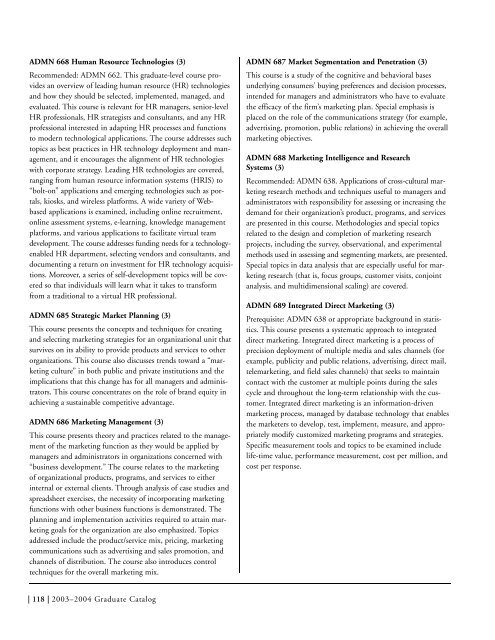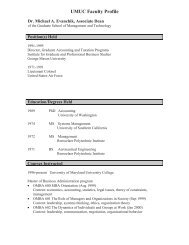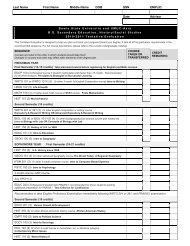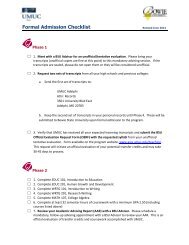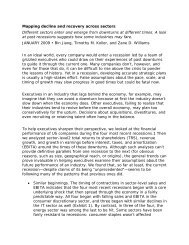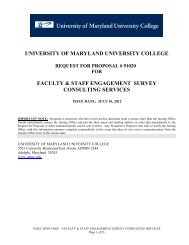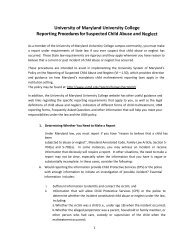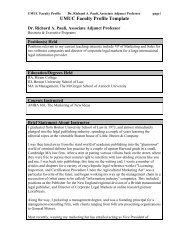A+B. Intro_SJ.1 - University of Maryland University College
A+B. Intro_SJ.1 - University of Maryland University College
A+B. Intro_SJ.1 - University of Maryland University College
You also want an ePaper? Increase the reach of your titles
YUMPU automatically turns print PDFs into web optimized ePapers that Google loves.
ADMN 668 Human Resource Technologies (3)<br />
Recommended: ADMN 662. This graduate-level course provides<br />
an overview <strong>of</strong> leading human resource (HR) technologies<br />
and how they should be selected, implemented, managed, and<br />
evaluated. This course is relevant for HR managers, senior-level<br />
HR pr<strong>of</strong>essionals, HR strategists and consultants, and any HR<br />
pr<strong>of</strong>essional interested in adapting HR processes and functions<br />
to modern technological applications. The course addresses such<br />
topics as best practices in HR technology deployment and management,<br />
and it encourages the alignment <strong>of</strong> HR technologies<br />
with corporate strategy. Leading HR technologies are covered,<br />
ranging from human resource information systems (HRIS) to<br />
“bolt-on” applications and emerging technologies such as portals,<br />
kiosks, and wireless platforms. A wide variety <strong>of</strong> Webbased<br />
applications is examined, including online recruitment,<br />
online assessment systems, e-learning, knowledge management<br />
platforms, and various applications to facilitate virtual team<br />
d e velopment. The course addresses funding needs for a technologyenabled<br />
HR department, selecting vendors and consultants, and<br />
documenting a return on investment for HR technology acquisitions.<br />
Moreover, a series <strong>of</strong> self-development topics will be covered<br />
so that individuals will learn what it takes to transform<br />
from a traditional to a virtual HR pr<strong>of</strong>essional.<br />
ADMN 685 Strategic Market Planning (3)<br />
This course presents the concepts and techniques for creating<br />
and selecting marketing strategies for an organizational unit that<br />
survives on its ability to provide products and services to other<br />
organizations. This course also discusses trends toward a “marketing<br />
culture” in both public and private institutions and the<br />
implications that this change has for all managers and administrators.<br />
This course concentrates on the role <strong>of</strong> brand equity in<br />
achieving a sustainable competitive advantage.<br />
ADMN 686 Marketing Management (3)<br />
This course presents theory and practices related to the management<br />
<strong>of</strong> the marketing function as they would be applied by<br />
managers and administrators in organizations concerned with<br />
“business development.” The course relates to the marketing<br />
<strong>of</strong> organizational products, programs, and services to either<br />
internal or external clients. Through analysis <strong>of</strong> case studies and<br />
spreadsheet exercises, the necessity <strong>of</strong> incorporating marketing<br />
functions with other business functions is demonstrated. The<br />
planning and implementation activities required to attain marketing<br />
goals for the organization are also emphasized. Topics<br />
addressed include the product/service mix, pricing, marketing<br />
communications such as advertising and sales promotion, and<br />
channels <strong>of</strong> distribution. The course also introduces control<br />
techniques for the overall marketing mix.<br />
ADMN 687 Market Segmentation and Penetration (3)<br />
This course is a study <strong>of</strong> the cognitive and behavioral bases<br />
underlying consumers’ buying pre f e rences and decision pro c e s s e s ,<br />
intended for managers and administrators who have to evaluate<br />
the efficacy <strong>of</strong> the firm’s marketing plan. Special emphasis is<br />
placed on the role <strong>of</strong> the communications strategy (for example,<br />
advertising, promotion, public relations) in achieving the overall<br />
marketing objectives.<br />
ADMN 688 Marketing Intelligence and Research<br />
Systems (3)<br />
Recommended: ADMN 638. Applications <strong>of</strong> cross-cultural marketing<br />
research methods and techniques useful to managers and<br />
administrators with responsibility for assessing or increasing the<br />
demand for their organization’s product, programs, and services<br />
are presented in this course. Methodologies and special topics<br />
related to the design and completion <strong>of</strong> marketing research<br />
projects, including the survey, observational, and experimental<br />
methods used in assessing and segmenting markets, are pre s e n t e d .<br />
Special topics in data analysis that are especially useful for marketing<br />
research (that is, focus groups, customer visits, conjoint<br />
analysis, and multidimensional scaling) are covered.<br />
ADMN 689 Integrated Direct Marketing (3)<br />
Prerequisite: ADMN 638 or appropriate background in statistics.<br />
This course presents a systematic approach to integrated<br />
direct marketing. Integrated direct marketing is a process <strong>of</strong><br />
precision deployment <strong>of</strong> multiple media and sales channels (for<br />
example, publicity and public relations, advertising, direct mail,<br />
telemarketing, and field sales channels) that seeks to maintain<br />
contact with the customer at multiple points during the sales<br />
cycle and throughout the long-term relationship with the customer.<br />
Integrated direct marketing is an information-driven<br />
marketing process, managed by database technology that enables<br />
the marketers to develop, test, implement, measure, and appropriately<br />
modify customized marketing programs and strategies.<br />
Specific measurement tools and topics to be examined include<br />
life-time value, performance measurement, cost per million, and<br />
cost per response.<br />
| 118 | 2003–2004 Graduate Catalog


